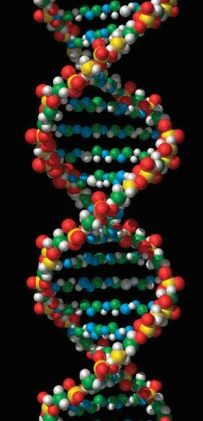|
IPRS, Inc.
|
|
|
The Magnesium Project - Genomics
In the early days of genetics, studies were done by observing the results of breeding plants or animals of particular phenotypes such as leaf or eye color. One determined whether inherited characteristics were dominant or recessive according to whether each parent or only one parent had a particular trait. With today's tools, and our understanding of the nature of genetic material (DNA - deoxyribonucleic acid), studies are more likely done on a molecular scale rather than a whole organism scale. This has ushered in the field of genomics - the study of genetics at the molecular level. We now know that DNA that resides in the cell nucleus carries all of the information needed to direct the synthesis of all of the chemicals needed by the organism. In the early days of genomics studies it was believed that for each protein made there was one gene on the DNA strand that was responsible for that protein. We now know that there may be multiple proteins produced from a gene and that there may be multiple genes involved in the synthesis of a particular protein. Genetic conditions may be pre-disposing for most of the diseases under consideration. Typically diseases are the result of multiple genetic defects which is the case for most cancers. Breast cancer for example is associated with at least 7 defects (copy number variations (CNV) or single nucleotide polymorphism (SNP)). Prostate cancer is associated with more than a dozen. A few diseases are of a single locus. Genomics starts with the DNA structure as elucidated by Watson and Crick is an alpha helix formed of a long string of nucleotides stitched together through four different base pairs and all attached to a phosphorylated sugar backbone. The four bases serve as the basis for a triplet code that identifies which amino acid should attach to which during protein synthesis. Other codes are for stopping or starting the reading of the code or carrying out other control functions. The tertiary structure is depicted in the figure in which each colored "ball" represents molecular components including the purines (adenine and guanine), pyrimidines (cytosine, uracil, thymine), phosphate and sugar (ribose) along with atoms of carbon, oxygen, hydrogen, nitrogen and phosphorous.
Photo made available for free at: Replication / Mitosis Translation to RNA Transcription to Protein Synthesis Genetics of Key Proteins in Cation Activity Genetics of Diseases linking to
Cation Regulation Dysfunction Genomic Research and Gene Expression These little understood mechanisms for magnesium ion regulation include their role in disease processes - diseases such as heart arrhythmia, maternal pre-eclampsia and eclampsia, high blood pressure, cell replication dysfunction, deficient energy production, muscle and nerve hyper- or hypo-activity, diabetes and more. We need your support to help us develop an international collaboration between government, academic and industrial scientists. GWAS - Genome Wide Association Studies. This is one type of study in which differences in expression of various genes is observed in a group of individuals. Studies may be conducted of multiple groups having different "phenotypes"; such as those with a high incidence of cancers versus those with a low incidence of the same disease. NGS (Next Generation Sequencing) tools continue to be developed bringing down the cost of sequencing. As a result it is more practical to identify transcription activity even at the cellular level. This has ushered in a new activity known as Transcriptomics. This discipline provides a huge boost to our protein/mRNA expression research enabling the discovery of novel proteins and regulatory systems. Epi-genetics -----------------------------------
© 2002 - 2024, All rights reserved, IPRS Inc. |
